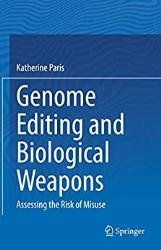 Название: Genome Editing and Biological Weapons: Assessing the Risk of Misuse
Название: Genome Editing and Biological Weapons: Assessing the Risk of MisuseАвтор: Katherine Paris
Издательство: Springer
Год: 2023
Страниц: 281
Язык: английский
Формат: pdf (true)
Размер: 10.2 MB
This monograph introduces current genome editing technologies—clustered regularly interspaced short palindromic repeat (CRISPR)-CRISPR-associated (Cas) systems, transcription activator-like effector nucleases (TALENs), and zinc-finger nucleases (ZFNs)—and provides an assessment of the risk of misuse of these technologies based on the following parameters: accessibility, ease of misuse, magnitude of potential harm, and imminence of potential misuse. The findings from this assessment are applied to analyze and evaluate the threat posed by the intentional misuse of genome editing technologies to develop biological weapons. Furthermore, the book discusses the implications of misuse for different applications of genome editing, such as making existing pathogens more dangerous, modifying the human microbiome, weaponizing gene drives, engineering super soldiers, and augmenting the general population to confer economic advantages.
Technologies that enable genome editing with programmable nucleases—including CRISPR, TALEN, and ZFN—allow for the precise genetic modification of organisms and cultured cells. While these technologies are used for a variety of beneficial applications, intelligence and defense experts have raised concerns that genome editing technologies, especially CRISPR, could be misused to develop new and improved biological weapons. Furthermore, experts worry that the number and type of actors who could potentially misuse genome editing is dramatically increasing given the democratization of biology, which is allowing biology to become more accessible to everyone including nonexperts.
The literature broadly groups biological warfare agents into four categories (only the last two of which are genetically engineered): traditional agents, emerging agents, genetically modified traditional agents, and advanced agents. Within the context of biodefense, an agent, also referred to as a biological agent or bioagent, is used to describe “any product created using biological components that may be intended to cause harm.” An agent could be “a pathogen, a toxin, or even a biological component.” A pathogen, or infectious agent, is defined as “a biological agent that causes disease or illness to its host.” This comparison of the agents in this section reveals the desirable attributes of a good biological weapon and provides context for the objectives that bioweaponeers who apply genetic engineering might try to achieve.
The book provides a comprehensive assessment of how feasible it is for users with different levels of knowledge and skill to acquire and then to apply the technologies to develop a biological weapon. It also provides an assessment of governability and a tailored set of recommendations that address security concerns. These recommendations are sensitive to the cost-benefit trade-off of regulating genome editing technologies. The book targets researchers as well as intelligence analysts, defense and security personnel, and policymakers.
Скачать Genome Editing and Biological Weapons: Assessing the Risk of Misuse